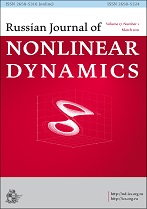|
Nonlinear physics and mechanics
The Extended Rigid Body and the Pendulum Revisited
M. de la Cruz, N. Gaspar, R. Linares
Departamento de Física, Universidad Autónoma Metropolitana Iztapalapa
San Rafael Atlixco 186, 09340, México City, México
Abstract:
In this paper we revisit the construction by which the $SL(2,\mathbb{R})$ symmetry of the Euler equations allows a simple pendulum to be obtained from a rigid body. We begin by reviewing the original relation found by Holm and Marsden in which, starting from the two integrals of motion of the extended rigid body with Lie algebra $\mathfrak{iso}(2)$ and introducing a proper momentum map, it is possible to obtain both the Hamiltonian and the equations of motion of the pendulum. Important in this construction is the fact that both integrals of motion have the geometry of an elliptic cylinder. By considering the whole $SL(2,\mathbb{R})$ symmetry group, in this contribution we give all possible combinations of the integrals of motion and the corresponding momentum maps that produce the simple pendulum, showing that this system can also appear when the geometry of one of the integrals of motion is given by a hyperbolic cylinder and the other by an elliptic cylinder. As a result, we show that, from the extended rigid body with Lie algebra $\mathfrak{iso}(1,1)$, it is possible to obtain the pendulum, but only in circulating movement. Finally, as a byproduct of our analysis we provide the momentum maps that give origin to the pendulum with an imaginary time. Our discussion covers both the algebraic and the geometric point of view.
Keywords:
free motion of a rigid body, simple pendulum, bi-Hamiltonian structures, momentum maps, symplectic reduction.
Received: 11.12.2019
Accepted: 20.03.2020
Citation:
M. de la Cruz, N. Gaspar, R. Linares, “The Extended Rigid Body and the Pendulum Revisited”, Rus. J. Nonlin. Dyn., 16:1 (2020), 133–159
Linking options:
https://www.mathnet.ru/eng/nd702 https://www.mathnet.ru/eng/nd/v16/i1/p133
|

| Statistics & downloads: |
| Abstract page: | 133 | | Full-text PDF : | 150 | | References: | 22 |
|




 Contact us:
Contact us: Terms of Use
Terms of Use
 Registration to the website
Registration to the website Logotypes
Logotypes








 Citation in format
Citation in format 